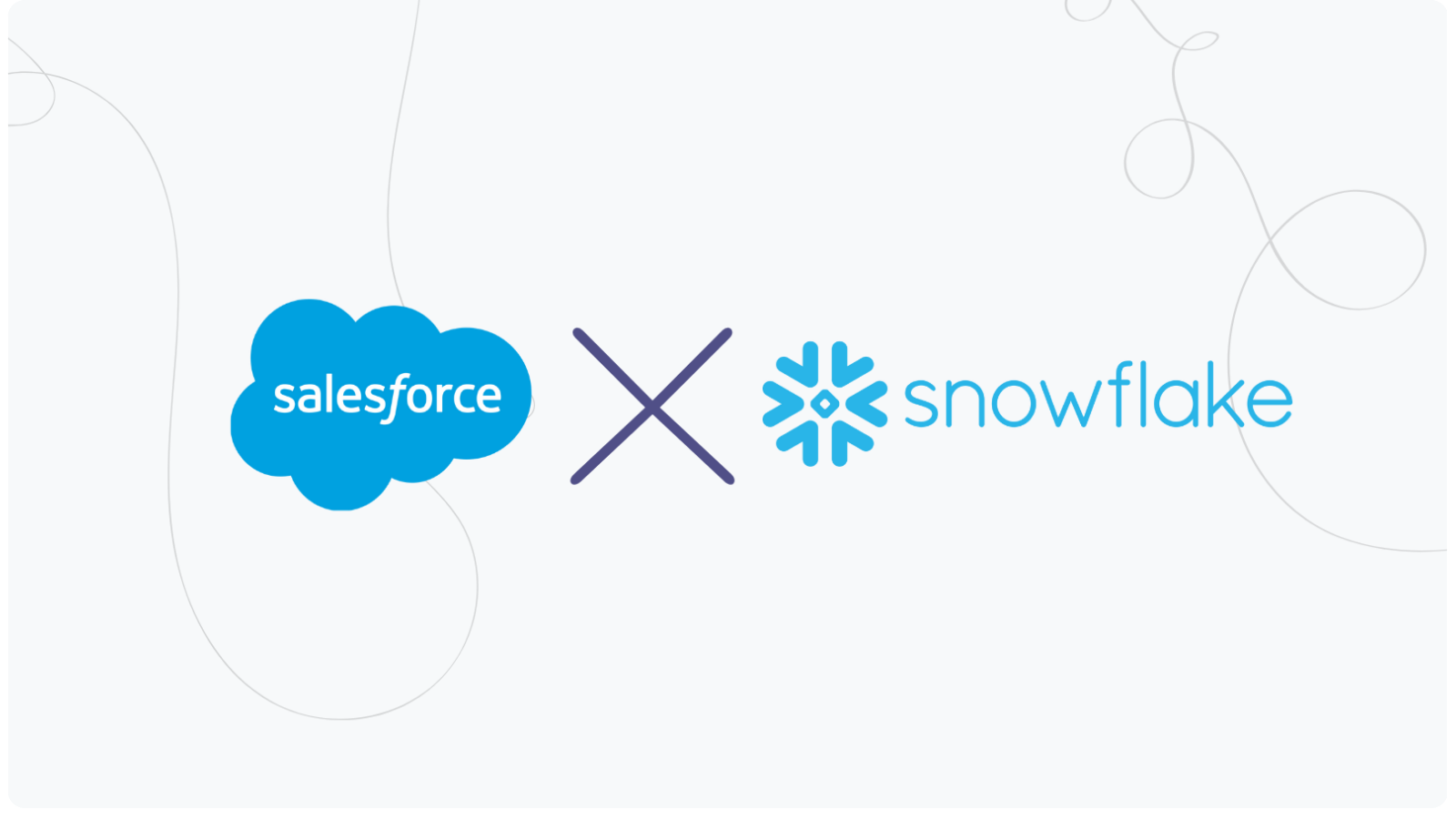Track Salesforce-to-Snowflake lineage by centralizing metadata, emitting job events, and using Snowflake access history plus catalogs to map changes.
***
Your Salesforce data can look perfectly fine in Snowflake… right up until someone asks a simple question you can’t answer:
“Why does this field have this value?”
If that field started life as a flag on an Account in Salesforce, you suddenly need to trace it across systems: from CRM object to ETL job to Snowflake table to downstream transformations. Without that end-to-end view, audits stall, compliance teams get nervous, and analysts lose trust in the numbers.
That’s why Salesforce to Snowflake is such a common — and yes, commonly fraught— pattern.
Salesforce is where operational GTM data is created and updated; Snowflake is where it’s modeled, joined, and analyzed. The pipeline between them is the spine of the modern revenue data stack, and lineage is how you keep that spine from breaking.
How Salesforce Data Typically Lands in Snowflake
In practice, Salesforce data usually arrives in Snowflake via an ETL/ELT pipeline or native connector.
Common approaches include:
- Commercial integrations (Fivetran, Talend, Informatica, Airbyte, etc.)
- Low-code flows (Salesforce Data Pipelines or MuleSoft)
- Custom code and frameworks
Salesforce itself offers a Snowflake Output Connector that can push object tables (Leads, Accounts, etc.) into Snowflake on a schedule. The connector automatically creates the target table and fields in Snowflake, offloading much of the manual schema setup.
Open-source frameworks like the DLT Python library let you script a pipeline from Salesforce to Snowflake. DLT’s docs highlight that it supports “data and schema lineage, facilitating traceability and understanding of how data moves and transforms within your data stack.”
In all of these flows, Salesforce metadata (object and field definitions, keys, data types) is read via APIs, while Snowflake metadata (table schemas, columns) is maintained directly in the warehouse. When new fields appear in Salesforce, the pipeline often has to adapt —f or example, by enabling dynamic schema handling where tools support it.
In one reported case, a team used Salesforce’s native connector to sync a multi-million-row Leads table into Snowflake hourly; the connector completed in under 2 minutes, enabling high-frequency loading of millions of records.
Where Lineage Data Comes From
Capturing lineage metadata requires instrumentation at each stage.
On the Snowflake side, enterprise accounts can use ACCESS_HISTORY (a system view of all reads/writes) to see which queries touched which tables. Snowflake documents that it “tracks how data flows from source to target objects” (e.g., tables created by CTAS or INSERT), and this built-in lineage powers impact analysis and compliance monitoring.
For example, Snowflake automatically logs that a table TABLE2 was created by selecting from TABLE1, so Snowsight can display an arrow from TABLE1 to TABLE2. This helps teams understand dependencies and trace where data originated within the warehouse.
On the Salesforce side, there is no equivalent out-of-the-box lineage view across objects, flows, and integrations, so the burden falls on pipelines and catalogs.
A modern best practice is to have the pipeline emit lineage events as it runs, instead of trying to reconstruct lineage after the fact.
The OpenLineage standard is designed for this. It defines a generic API for “jobs” (data processes) and their “datasets,” allowing any tool to report what it read and wrote. In OpenLineage’s model, a dataset can be almost anything—e.g., a Snowflake table or a CRM object.
Concretely, a reverse-ETL job might emit an event whose inputs include a Snowflake table and whose outputs include a Salesforce object. Once captured, these events feed into a lineage store (like Marquez or an enterprise catalog), which assembles the end-to-end graph.
Catalogs, Governance Platforms, and Observability
Many organizations use metadata governance platforms to consolidate lineage across systems.
Commercial catalogs like Alation and Collibra automatically scan databases and BI tools to harvest lineage. Alation, for example, advertises that it “automatically captures metadata [and] tracks how data moves and transforms from source to destination,” providing interactive lineage visualizations for analysts.
Open-source platforms like Apache Atlas provide a central metadata repository and UI for lineage.
Atlas is pretty flexible, integrates well with Hadoop/Spark/Hive-style stacks, and is free (though technically intensive to run). Emerging tools such as DataHub and OpenMetadata have connectors for Salesforce and Snowflake, allowing them to ingest schemas, profiles, and lineage data on both sides.
On top of this, data observability platforms like Sweep can layer in anomaly detection and freshness monitoring tied back to the lineage graph.
The net effect: catalogs and observability tools become the shared map of how CRM data travels into, through, and out of Snowflake.
Key Challenges in Cross-Cloud Lineage
Even with strong tools, Salesforce to Snowflake lineage comes with a few recurring problems.
1. Schema drift (and hidden connector limits)
Schema drift is the big one. Salesforce admins can add or remove fields, or change types, at any time. If your pipelines don’t react, downstream tables in Snowflake quietly go out of sync.
A critical detail here: Salesforce’s own connector requires you to manually select fields to sync. That means any new custom field added in Salesforce will not automatically appear in Snowflake — you have to update the connector configuration and rerun the pipeline. This limitation is often discovered only after a missing field breaks a report.
In ETL terms, one common mitigation is change-data-capture (CDC): instead of overwriting rows in place, you write each change as a new row. This lets the warehouse append schema changes over time without rewriting historical data. Practitioners often recommend making ingestion “dynamic so we don’t have to constantly remap fields manually.”
2. Semantic mismatches
Next, semantics. Always fun.
Field names and formats don’t always align across systems (e.g., a contact_id in Salesforce vs. person_id in analytics tables). Data catalogs or business glossaries have to reconcile these differences so that analysts understand which fields are actually equivalent and which are not.
3. Security, identity, and latency
Cross-cloud environments also mean different security and identity domains. Teams must manage credentials (OAuth tokens for Salesforce APIs, Snowflake service accounts), and lineage metadata itself needs to be access-controlled—especially when it reflects sensitive objects or regulatory scopes (GDPR, HIPAA, etc.).
Latency adds another wrinkle: if Salesforce syncs only once per day, “near real-time” views in Snowflake can lag significantly, making impact analysis harder. A broken dashboard might be caused by an object change that hasn’t yet landed in Snowflake.
In short, lineage is easiest when pipeline definitions are treated as code: Airflow DAGs, NiFi flows, ADF pipelines, etc., should be version-controlled in Git, with changes tracked just like application code.
Best Practices for Salesforce to Snowflake Lineage
Good lineage for this pattern is less about a single tool and more about a set of habits. A few practical anchors:
- Centralize metadata across both systems
- Ingest Salesforce schema and usage into the same catalog as Snowflake’s.
- Tag fields with business terms so their meaning carries across systems (e.g., “ARR,” “Primary Contact,” “Opportunity Stage”).
- Emit OpenLineage (or equivalent) events from every job
- Configure ETL/ELT tools to emit job-level lineage events for each run.
- Use frameworks like Marquez, DataHub, or OpenMetadata that already speak the OpenLineage spec.
- Lean on Snowflake’s native lineage for the warehouse side
- Enable and query ACCESS_HISTORY as the authoritative source for read/write lineage inside Snowflake.
- Use Snowsight’s lineage UI to visualize dependencies and confirm what is actually downstream of a given table or view.
- Apply change management to pipelines
- Keep NiFi, Airflow, ADF, or similar flows in Git for auditability.
- Include version labels or run IDs in lineage metadata so you can tie a data issue back to a specific deployment.
- Plan explicitly for schema drift
- When drift is likely, favor CDC or delta-style syncing (append-only change rows) so structural changes show up as new nodes in the lineage graph rather than invisible mutations.
- For native connectors like Salesforce’s, document the manual field-selection behavior and bake connector configuration updates into your change process.
- Reconcile semantics with glossaries and “business entities”
- Use business glossaries or entity models to align CRM fields and warehouse columns (e.g., ensure “CloseDate” in Salesforce clearly maps to the correct date column in Snowflake).
- Avoid homonyms by standardizing names for key concepts across both systems.
- Keep catalogs and scanners fresh
- Refresh catalog scans on a regular schedule so new Salesforce fields trigger new Snowflake columns and corresponding lineage edges.
- Treat stale catalog metadata as a risk, not a minor annoyance.
Connecting Salesforce to Snowflake in a traceable way is ultimately a process problem with a metadata solution.
Most organizations end up stitching together SaaS connectors, ETL jobs, and open-source agents (OpenLineage clients, Apache Atlas/DataHub/OpenMetadata integrations) to continuously publish lineage metadata. Combined with Snowflake’s native lineage features, this yields a usable, end-to-end graph of how CRM data flows into analytics.
The payoff will arrive the next time something changes in Salesforce or a dashboard breaks: instead of guessing, analysts can follow the lineage graph straight back to the source, understand the blast radius, and restore trust in the pipeline.
How is Sweep Implicated In All This?
As you start wiring Salesforce lineage into Snowflake, this is exactly where Sweep is headed.
Sweep’s metadata agents are built to understand Salesforce and Snowflake — so you can see every field, flow, and pipeline in one governed graph. If you want Salesforce-to-Snowflake lineage without duct-taping five tools together, Sweep is the place to start.

